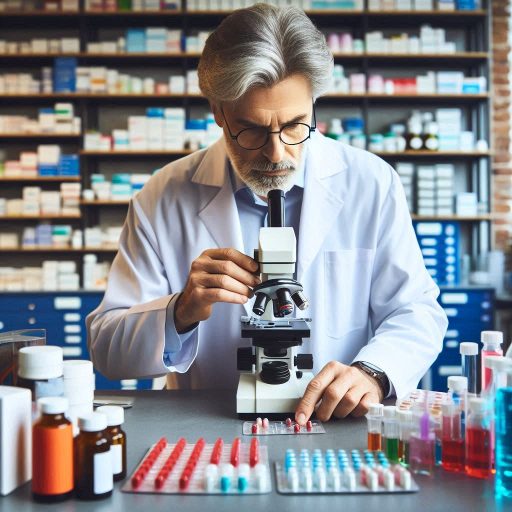Introduction
In the ever-evolving field of pharmacology, tools and technologies have become indispensable in advancing research and improving drug discovery processes.
These advancements enable pharmacologists to conduct more sophisticated analyses, streamline experiments, and make data-driven decisions with greater precision.
From molecular modeling software that predicts drug interactions to high-throughput screening systems that test thousands of compounds rapidly.
The integration of modern technologies has revolutionized how pharmacologists work.
Technological advancements have also enabled pharmacologists to analyze vast amounts of complex biological data through bioinformatics platforms.
Uncovering new therapeutic targets and insights that were previously unattainable.
These innovations have not only accelerated the drug development timeline but have also improved the accuracy of research findings, reducing the risk of costly failures later in the process.
The purpose of this blog post is to examine the essential tools and technologies that have transformed the field of pharmacology.
By understanding and utilizing these cutting-edge resources, pharmacologists can enhance their research capabilities.
Drive meaningful progress, and contribute to the development of more effective treatments for various diseases.
Traditional laboratory tools
Common Laboratory Tools Used by Pharmacologists
Pharmacologists frequently use traditional laboratory tools such as beakers, test tubes, and petri dishes in their daily work.
Beakers, with their wide openings, are used to mix and measure chemicals.
They allow for easy handling of liquids and facilitate controlled reactions.
Test tubes, slender and small, are ideal for conducting reactions in smaller volumes, making them essential for precise experimental setups.
Petri dishes, shallow circular containers, are crucial for growing and studying microorganisms in drug development.
Each of these tools plays a vital role in pharmacological research, enabling accurate experimentation and data collection.
How These Tools Are Essential for Conducting Experiments and Drug Development
These traditional tools are essential for conducting experiments and advancing drug development.
Beakers are used to mix compounds safely, ensuring that reactions occur under controlled conditions.
Pharmacologists use test tubes to handle minute quantities of chemicals, enabling them to study reactions on a small scale.
Petri dishes are crucial in microbiological studies, allowing researchers to observe how microorganisms respond to various drug compounds.
The data collected from these tools enable scientists to understand the effects of drugs at the molecular level, helping them create safer and more effective treatments.
The Importance of Proper Handling and Maintenance of Traditional Laboratory Tools
Proper handling and maintenance of traditional laboratory tools are critical to ensuring accurate experimental results.
Beakers, test tubes, and petri dishes must be cleaned thoroughly before and after use to avoid contamination.
Mismanagement of these tools can lead to incorrect data, affecting the outcomes of experiments.
Pharmacologists must also handle these tools with care to prevent breakage, which could result in dangerous chemical spills.
Regular maintenance and careful use of these laboratory tools help maintain the integrity of experiments, ensuring that researchers obtain reliable results for drug development and safety testing.
Automation technologies
The Use of Automation Technologies in Pharmacology
Automation technologies such as liquid handling robots and high-throughput screening systems are revolutionizing pharmacology.
Liquid handling robots can precisely manage large volumes of liquid samples, reducing human error and speeding up experiments.
High-throughput screening systems allow pharmacologists to test thousands of chemical compounds quickly and efficiently.
These tools enable researchers to automate repetitive tasks, such as pipetting or sample transfers, freeing them to focus on data analysis and complex decision-making.
The integration of these advanced technologies has become essential for modern drug development.
How Automation Streamlines the Drug Discovery Process and Improves Efficiency
Automation technologies significantly streamline the drug discovery process by speeding up experiments and increasing accuracy.
Liquid handling robots handle complex operations faster than humans, reducing the time required for setting up tests.
High-throughput screening systems allow for rapid testing of numerous drug candidates, identifying those with potential efficacy more efficiently.
By minimizing manual intervention, automation reduces the risk of errors, leading to more reliable results.
These tools also enable pharmacologists to collect and process data at a scale previously impossible, accelerating the journey from initial research to clinical trials.
Examples of Successful Drug Development Projects That Have Utilized Automation Technologies
Several successful drug development projects have utilized automation technologies to enhance their processes.
One notable example is the discovery of remdesivir, a treatment for viral infections, which was identified through high-throughput screening.
Automation systems allowed researchers to test thousands of compounds, significantly speeding up the identification of promising candidates.
Similarly, the development of cancer immunotherapies has benefited from automation, where liquid handling robots and screening technologies have been used to test the effects of new drugs on immune cells.
These examples illustrate the transformative impact of automation in advancing life-saving treatments.
Read: How Climate Change Is Impacting Plant Research
Imaging technologies
The Significance of Imaging Technologies in Pharmacology
Imaging technologies such as MRI, CT scans, and fluorescence microscopy are crucial tools in pharmacology.
Magnetic Resonance Imaging (MRI) and Computed Tomography (CT) scans provide detailed images of internal structures, allowing researchers to observe how drugs interact with the body.
Fluorescence microscopy enables the visualization of specific cells and molecules, making it easier to track biological processes at the cellular level.
These imaging technologies are indispensable for understanding the effects of drugs in living organisms, from large-scale anatomical changes to cellular interactions.
How These Technologies Help Pharmacologists Visualize Biological Processes and Drug Interactions
Imaging technologies help pharmacologists visualize biological processes and drug interactions in real-time.
MRI and CT scans allow researchers to monitor how drugs distribute throughout the body, offering insight into pharmacokinetics and pharmacodynamics.
Fluorescence microscopy provides a closer look at how drugs affect cells, tissues, and individual molecules.
These technologies give pharmacologists a comprehensive understanding of drug mechanisms, enabling them to refine formulations and dosages.
By visualizing drug interactions, scientists can better predict efficacy and side effects, improving the overall drug development process.
Recent Advancements in Imaging Technologies That Have Enhanced Drug Discovery Research
Recent advancements in imaging technologies have greatly enhanced drug discovery research.
One breakthrough is the development of super-resolution fluorescence microscopy, which allows researchers to observe molecular structures at a nanoscopic level.
This technology provides unprecedented insight into how drugs interact with their cellular targets.
Another advancement is the integration of AI with imaging tools, which accelerates data analysis and interpretation.
AI-driven image analysis helps identify subtle patterns in biological responses to drugs, expediting the drug discovery timeline.
These innovations have made drug research more precise and efficient, opening new avenues for medical breakthroughs.
Read: Exploring the Different Branches of Geology
Data analysis software
The Importance of Data Analysis Software in Pharmacology
Data analysis software plays a crucial role in pharmacology by enabling researchers to process and interpret large datasets.
With the increasing complexity of drug development, pharmacologists rely on these tools to analyze experimental data efficiently.
From understanding how drugs interact with biological systems to identifying patterns in clinical trials, data analysis software helps researchers handle the vast amount of information generated in modern pharmacological studies.
Without these tools, managing and interpreting data accurately would be impossible.
Popular Software Tools Like Python, R, and MATLAB
Pharmacologists commonly use data analysis tools like Python, R, and MATLAB to manage and analyze their research data.
Python is popular for its flexibility and large library of scientific tools like NumPy, Pandas, and SciPy, which streamline data manipulation and analysis.
R, widely used in statistical analysis, offers pharmacologists robust packages for bioinformatics and drug efficacy studies.
MATLAB, known for its powerful mathematical capabilities, is ideal for modeling complex pharmacological processes.
These software tools help researchers perform statistical analysis, create visualizations, and build predictive models in drug discovery.
How Data Analysis Software Helps Pharmacologists Make Informed Decisions
Data analysis software enables pharmacologists to make informed decisions by offering deep insights from experimental data.
It helps researchers identify trends, correlations, and anomalies in drug trials, allowing them to adjust experiments or move forward with promising compounds.
Additionally, these tools help identify potential drug targets by analyzing biological pathways and predicting how drugs interact with them.
By integrating data from various sources, software tools provide comprehensive views that guide research decisions, improving the chances of developing effective and safe drugs.
Read: Top Skills Needed for a Successful Geology Career

Molecular modeling tools
The Role of Molecular Modeling Tools in Drug Design
Molecular modeling tools, such as molecular docking and molecular dynamics simulations, play a vital role in drug design.
These tools allow pharmacologists to visualize and simulate the structure of molecules at the atomic level.
Molecular docking helps researchers predict how a drug will bind to its target, while molecular dynamics simulations track the behavior of molecules over time.
By studying these interactions, scientists can design drugs that precisely target specific proteins or receptors.
Making molecular modeling an essential step in drug discovery and development.
How These Tools Help Pharmacologists Predict Drug-Target Interactions
Molecular modeling tools enable pharmacologists to predict interactions between drugs and biological targets with high accuracy.
Using molecular docking, researchers simulate how a drug fits into the binding site of a target protein.
This process allows them to evaluate the strength and stability of the interaction, ensuring that the drug will act as intended.
Molecular dynamics simulations offer additional insights by showing how these interactions change over time, revealing potential side effects or adjustments needed in the drug design.
These tools give pharmacologists a deeper understanding of how drugs will function in the body before moving to clinical trials.
The Benefits of Molecular Modeling in Accelerating Drug Discovery and Reducing Costs
Molecular modeling significantly accelerates the drug discovery process and reduces development costs.
By simulating drug-target interactions in silico, researchers can quickly eliminate ineffective compounds, focusing only on those with the highest potential.
This targeted approach reduces the need for costly and time-consuming laboratory experiments.
Additionally, molecular modeling allows for faster iterations of drug design, enabling the rapid refinement of drug candidates.
As a result, pharmaceutical companies can bring effective treatments to market faster and with fewer resources, making molecular modeling a powerful tool in modern pharmacology.
Read: The Future of Botany: Emerging Fields and Innovations
Transform Your Career Today
Unlock a personalized career strategy that drives real results. Get tailored advice and a roadmap designed just for you.
Start NowBioinformatics resources
The Relevance of Bioinformatics Resources in Pharmacology
Bioinformatics resources are highly relevant in pharmacology for analyzing biological data and genomes.
These resources help pharmacologists understand complex biological systems by integrating and interpreting vast amounts of genomic and proteomic data.
They provide tools and databases that facilitate the study of gene functions, protein interactions, and metabolic pathways.
By leveraging bioinformatics, researchers can gain insights into how drugs affect biological systems, identify potential drug targets, and personalize treatments based on genetic information.
Ultimately, bioinformatics enhances the efficiency and accuracy of drug discovery and development processes.
Popular Databases and Tools Used by Pharmacologists
Pharmacologists frequently use popular bioinformatics databases and tools, including GenBank, UniProt, and BLAST.
GenBank is a comprehensive database of nucleotide sequences, providing valuable information about genes and their functions.
UniProt offers detailed protein sequence and functional information, allowing researchers to study protein interactions and pathways relevant to drug action.
BLAST (Basic Local Alignment Search Tool) enables pharmacologists to compare biological sequences, helping them identify homologous genes and proteins across different organisms.
These resources are essential for understanding the molecular basis of diseases and drug responses.
Examples of How Bioinformatics Resources Have Contributed to Understanding Drug Metabolism and Pharmacokinetics
Bioinformatics resources have significantly contributed to understanding drug metabolism and pharmacokinetics.
For example, researchers have used GenBank to identify genes encoding enzymes responsible for drug metabolism, such as cytochrome P450 enzymes.
This information helps pharmacologists predict how individuals metabolize specific drugs based on their genetic makeup.
UniProt has facilitated the study of protein interactions involved in drug transport, shedding light on absorption and distribution processes.
Additionally, bioinformatics tools have helped identify genetic variations that affect drug response, enabling the development of personalized medicine strategies.
These advancements highlight the crucial role of bioinformatics in modern pharmacology.
Find Out More: Top Skills Required for Seismologists
Personalized medicine technologies
The Emerging Field of Personalized Medicine and Its Impact on Pharmacology
Personalized medicine is an emerging field that tailors medical treatments to individual patient characteristics, particularly in pharmacology.
This approach considers genetic, environmental, and lifestyle factors to optimize drug therapy for each patient.
By using personalized medicine, pharmacologists can develop targeted therapies that enhance drug efficacy and minimize side effects.
This paradigm shift in healthcare impacts how drugs are designed, tested, and prescribed, emphasizing the importance of individualized treatment plans.
As personalized medicine continues to evolve, it holds the promise of revolutionizing patient care and improving health outcomes.
Technologies That Enable Personalized Treatment Approaches
Technologies like next-generation sequencing (NGS) and liquid biopsy are crucial for enabling personalized treatment approaches in pharmacology.
Next-generation sequencing allows researchers to rapidly sequence entire genomes, identifying genetic variations that influence drug response.
This technology helps pharmacologists understand how specific mutations affect drug metabolism and efficacy.
Liquid biopsy is another innovative technology that analyzes circulating tumor DNA from a blood sample.
This method enables real-time monitoring of tumor evolution and treatment response, allowing for timely adjustments in therapy.
Together, these technologies empower pharmacologists to tailor treatments based on a patient‘s unique genetic makeup and disease characteristics.
The Potential of Personalized Medicine Technologies in Improving Patient Outcomes
Personalized medicine technologies have the potential to significantly improve patient outcomes and reduce adverse drug reactions.
By tailoring treatments to an individual‘s genetic profile, pharmacologists can select the most effective therapies while minimizing the risk of side effects.
This approach enhances the likelihood of successful treatment outcomes, as medications can be optimized for each patient.
Additionally, personalized medicine can lead to more efficient drug development processes by focusing on specific patient populations.
Ultimately reducing costs and time in bringing new therapies to market.
As these technologies advance, they will continue to reshape the landscape of pharmacology and patient care, fostering a more precise and effective approach to medicine.
Conclusion
Pharmacologists rely heavily on a range of essential tools and technologies to drive advancements in drug discovery and development.
These tools include molecular modeling software, which helps predict how drugs will interact with biological targets.
High-throughput screening systems allow pharmacologists to quickly test thousands of compounds, accelerating the identification of potential drug candidates.
Bioinformatics platforms are crucial for analyzing vast amounts of data, making sense of complex biological processes, and uncovering new therapeutic possibilities.
Staying updated with the latest technological advancements is vital for successful research in this field.
As technology evolves, it opens new doors for innovation, making it easier for pharmacologists to conduct more precise and efficient experiments.
Those who embrace these advancements can streamline their processes, improve accuracy, and significantly reduce the time it takes to bring new drugs to market.
Pharmacologists are encouraged to leverage these tools to enhance their research, contribute to the growing body of knowledge in the field, and ultimately improve patient care.
Continuous learning and adapting to new technologies will keep them at the forefront of pharmacology, enabling them to make meaningful contributions to healthcare.
By integrating these essential tools and technologies, pharmacologists can push the boundaries of what is possible in drug discovery and development.




